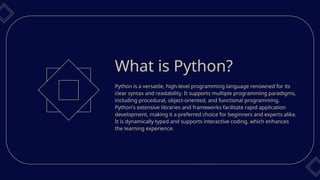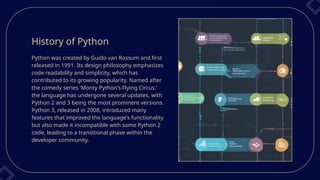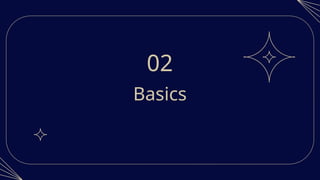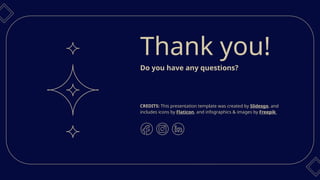Python Basics and other uses of programming
- 1. Python Explore the fundamentals and key features of Python programming language.
- 2. Python is a high-level, interpreted programming language known for its readability and simplicity. It is widely used in various fields such as web development, data science, artificial intelligence, and more. This presentation will cover the basics of Python, including its key features and historical background. Introduction
- 3. Intro 01
- 4. Python is a versatile, high-level programming language renowned for its clear syntax and readability. It supports multiple programming paradigms, including procedural, object-oriented, and functional programming. Python's extensive libraries and frameworks facilitate rapid application development, making it a preferred choice for beginners and experts alike. It is dynamically typed and supports interactive coding, which enhances the learning experience. What is Python?
- 5. History of Python Python was created by Guido van Rossum and first released in 1991. Its design philosophy emphasizes code readability and simplicity, which has contributed to its growing popularity. Named after the comedy series 'Monty Python's Flying Circus,' the language has undergone several updates, with Python 2 and 3 being the most prominent versions. Python 3, released in 2008, introduced many features that improved the language's functionality but also made it incompatible with some Python 2 code, leading to a transitional phase within the developer community.
- 6. Python is used in various domains such as web development with frameworks like Django and Flask, data analysis and visualization using libraries like Pandas and Matplotlib, artificial intelligence and machine learning with TensorFlow and Scikit-learn, automation scripts, game development, and scientific computing. Its versatility and ease of use make Python a preferred language for startups and large organizations alike. Applications of Python
- 7. Basics 02
- 8. Python's syntax is designed to be clean and easy to understand. Code blocks are defined using indentation rather than braces or keywords, making it visually distinct. Key aspects of its syntax include variable assignment, function definitions, and control flow statements. The use of comments for code documentation is emphasized, fostering readability and maintainability in programming practices. Syntax and Semantics
- 9. Python supports several built-in data types including integers, floats, strings, lists, tuples, dictionaries, and sets. Variables are dynamically typed, meaning that their type is determined at runtime. This flexibility allows for easy manipulation of different data types. Understanding and using these data types effectively is crucial for writing efficient and logical Python code. Data Types and Variables
- 10. Control Structures Control structures in Python include conditional statements (if, elif, else) and looping constructs (for and while loops). These structures are essential for making decisions and executing repeated tasks in code. The use of 'break' and 'continue' statements within loops allows for enhanced control over execution flow. Mastery of control structures enables developers to create dynamic and responsive programs.
- 11. Python is a powerful, easy-to-learn programming language that supports a vast range of applications. From web development to data analysis, its clean syntax and flexibility make it popular among both beginners and experienced programmers. Understanding the basics of Python sets the foundation for further exploration in various exciting fields of programming and technology. Conclusions
- 12. CREDITS: This presentation template was created by Slidesgo, and includes icons by Flaticon, and infographics & images by Freepik Thank you! Do you have any questions?











